
Quick Navigation
- Why Do Flip-Flops Cause Foot Problems?
- Problems and Symptoms That Arise From Flip-Flop Use
- Flip-Flop Injury Statistics
- Best Alternatives to Flip-Flops
- Treatment
- Contact
It’s the telltale sign that summer has arrived — when flip-flops become the go-to footwear on every pair of feet. While you cling to your favorite pair of open shoes for convenience and comfort, experts cringe at the idea of people wearing them daily. While flip-flops may not be a bad choice for an occasional trip to the beach or visit to the spa, they shouldn’t be your primary footwear.
OrthoBethesda specialists are here to show you the dangers of flip-flops. Yes, some may look stylish or feel casual on a hot summer day, but many people can suffer from foot pain. We will take you through common symptoms associated with flip-flops and provide a list of the best alternatives for your feet.
Why Do Flip-Flops Cause Foot Problems?
Flip-flops, also known as shoe thongs in some areas, don’t offer any arch support for your foot. Because the sole of flip-flops is thin rubber or another material, your foot is as flat as possible — which, for most people, is not ideal. You can suffer from arch and heel soreness, as well as foot pains and excessive pressure.
The footwear also doesn’t provide any protection for your feet and has no heel cushioning. Instead, a thin rubber material acts as the sole of the shoe. Because your heel often has less than one inch of protection from the ground, flip-flops don’t offer shock absorption. When you’re walking, your feet endure extreme amounts of force.
When you wear a shoe thong with no arch, ankle or heel support, protection or shock absorption, you can suffer from foot pain, sprained ankles or tendinitis. If you wear flip-flops for extended periods, you increase the risk of foot injuries, discomfort and other bodily sorenesses.
Several adverse effects of wearing flip-flops include blisters, foot fungus, balance issues, strained or overextended tendons, shooting pains, plantar fasciitis, foot swelling and more.
At best, moderation will help you avoid these discomforts. Wear flip-flops only when you find it most necessary. For example, wearing shoe thongs to the beach, pool, spa or public shower is often practical. However, they are not ideal for extensive walking or hiking activities. Try to avoid walking long distances, and wear them for shorter periods of movement like running errands.
Wearing flip-flops in the wrong environments can also lead to other and more temporary external pains. You can step on rocks, pebbles or even sharper objects that puncture through the rubber. If something pierces through the material, you can experience incredible pain or even penetration wounds. Stepping onto irregular objects with a thin piece of protection under your foot can cause almost as much pain as stepping on things barefoot.
You can also cut your heels walking down steps as you misjudge your gait, scraping your heel against concrete. Wearing flip-flops can increase the risk of glass cuts, stubbed or broken toes and torn nail beds. You even expose your feet to the possibility of heavy objects crushing your toes. Flip-flops are notorious for worsening your existing problems, too.
Shoe thong materials can include latex, which some people are allergic to. Some consist of BPA-laden plastic — a substance linked to several cancers. If your flip-flops have porous materials, they can even retain water and harbor fungal and viral bacteria.
If you’re wondering if flip-flops can cause nerve pain and other issues, the short answer is yes. We will discuss more in-depth solutions to help you understand the effects of flip-flops.
Problems and Symptoms That Arise From Flip-Flop Use
While flip-flops are all the craze once the warmer months roll around, people tend to rely on them more than necessary. If you stick to wearing this unsupportive and unprotected form of footwear only during specific occasions, you can limit the possible long-term effects. However, when you start slipping on the flip-flops as your daily attire, problems begin to arise.
Continuously wearing flip-flops can affect various parts of your body, such as your posture, toes, skin, heels and arches.
Affect Your Posture
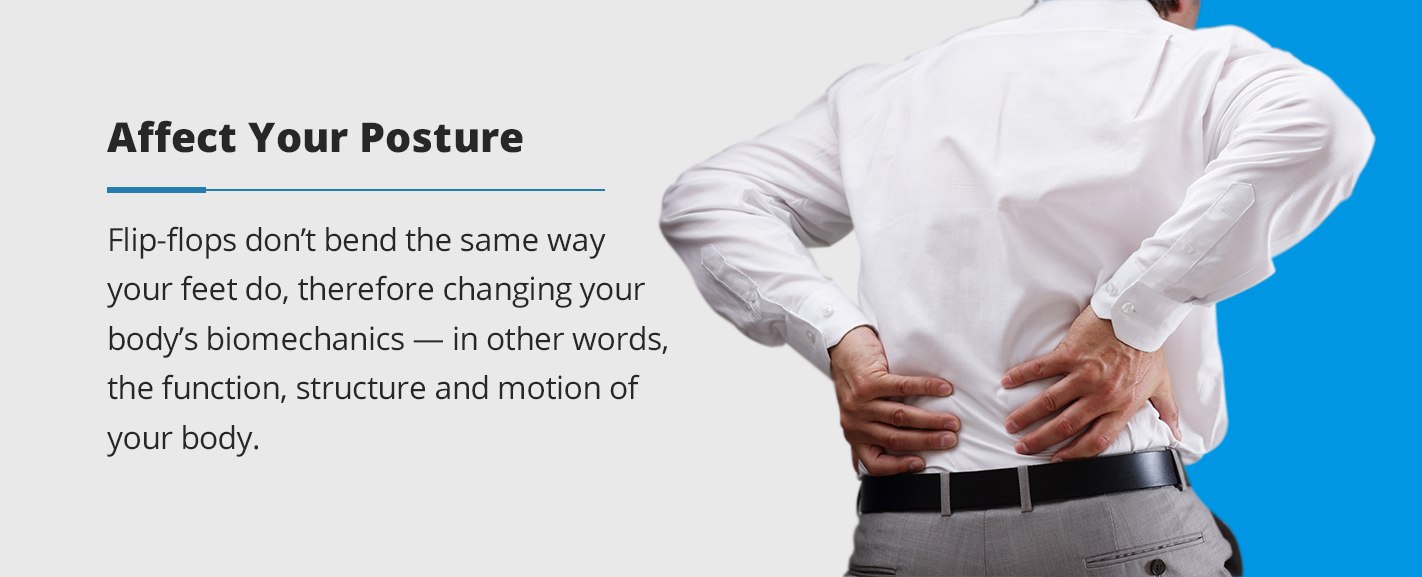
Choosing to dress in flat shoes can affect the way you walk and stand — and not in the best way. Flip-flops don’t bend the same way your feet do, therefore changing your body’s biomechanics — in other words, the function, structure and motion of your body.
Flip-flops can affect your physique beyond your feet by aggravating your joints and messing with your body’s proper alignment. The shoes can also increase knee, lower back and hip pain, causing you to position yourself in various postures to reduce the amount of agony. Without the proper arch and heel support, your hips, knees and back can suffer from alignment issues.
When you stand flat-footed, you can begin to feel pain during most physical activities.
Cause Hazardous Driving
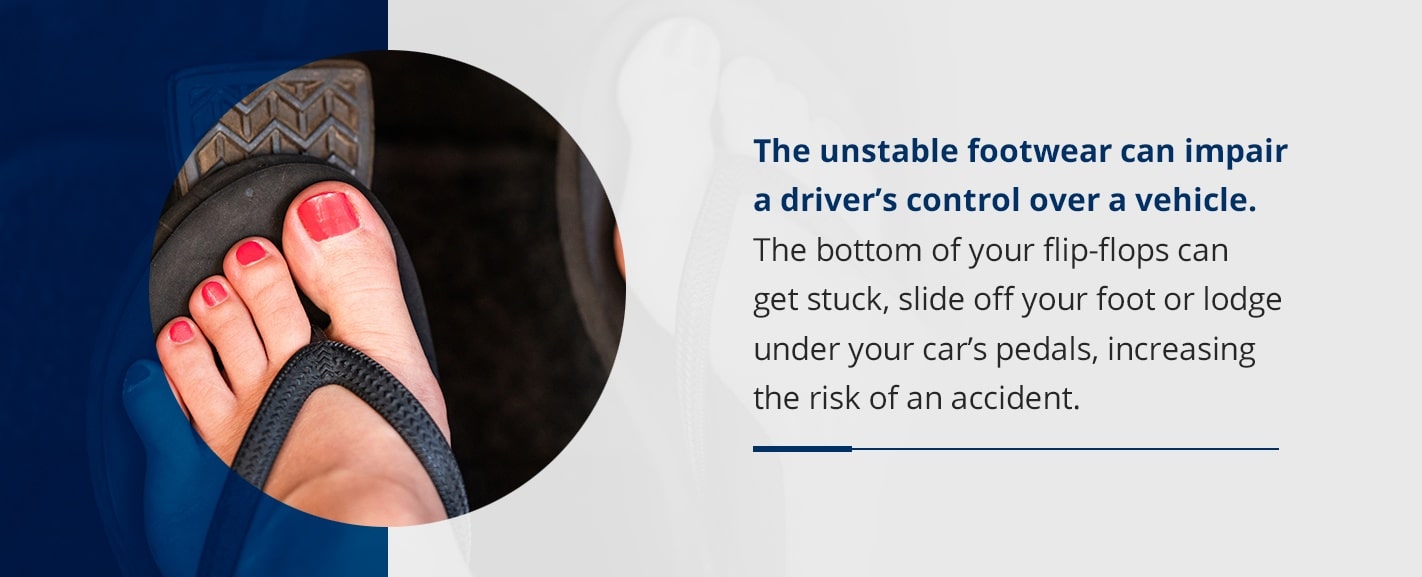
On top of causing bodily pains and irritations, flip-flops can also result in other problems, like hazardous driving. The unstable footwear can impair a driver’s control over a vehicle. For example, the bottom of your flip-flops can get stuck, slide off your foot or lodge under your car’s pedals, increasing the risk of an accident.
Your flip-flops can even get stuck as you’re moving your foot from one pedal to the next. If you’re struggling to free your foot from the accelerator or brake, you may not be able to react as necessary. You also should not drive barefoot for hygienic reasons. Your car’s pedals are full of dirt, debris and other contaminants.
Cause Shooting Pains
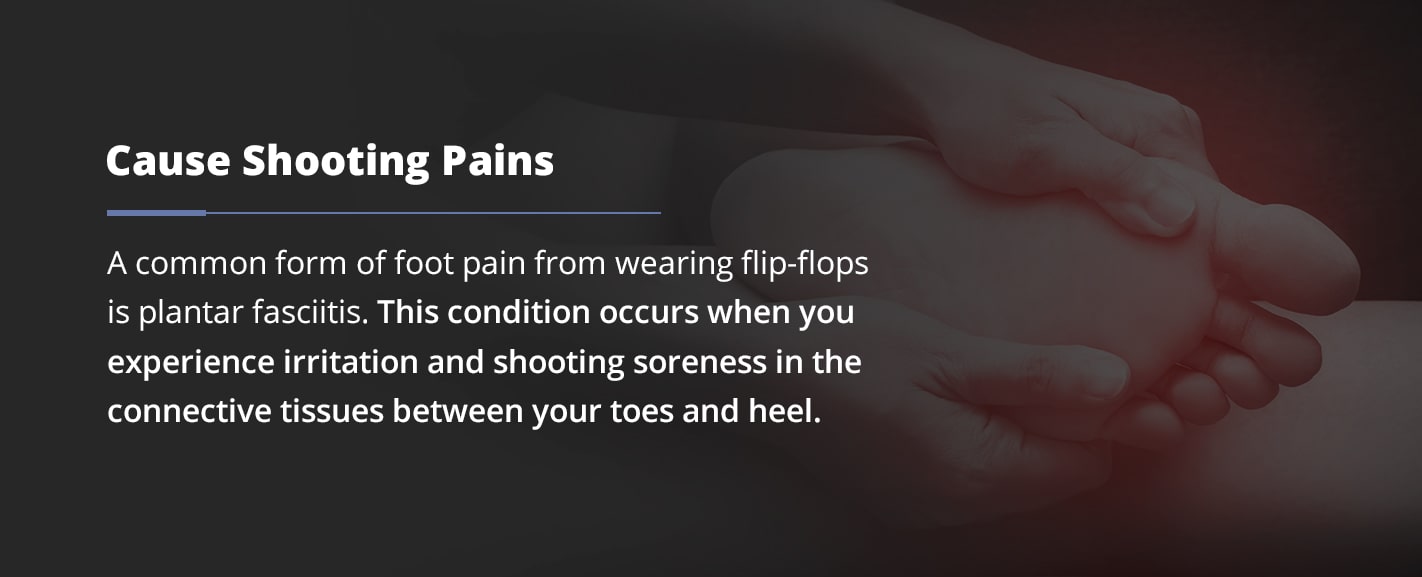
Everyone needs the right amount of arch support — whether you have flat feet or a high arch — and flip-flops don’t provide any at all. Your joints have to work extra hard in flat footwear, which can lead to the overuse of your ligaments. You can begin to feel sharp pains up your body from heel strains, pinched back nerves and an aching Achilles tendon.
A common form of foot pain from wearing flip-flops is plantar fasciitis. This condition occurs when you experience irritation and shooting soreness in the connective tissues between your toes and heel. You can often feel discomfort on the bottom or inside of your heel.
Your foot’s plantar fascia tissue supports your natural arch and becomes taut when your foot bears weight. But if you place repetitive stress and excessive tension on the tissue, you can experience plantar fasciitis. Flip-flops require your feet and toes to work harder to keep the shoe on your foot, which can inflame the tissue.
A common effect of having plantar fasciitis is a heel spur, which can cause heel pain. A heel spur is a bony protrusion located at the underside of your heel bone. It forms because of strained foot ligaments and muscles, as well as stretching of the plantar fascia tissue.
Aside from plantar fasciitis, can flip-flops cause neuropathy? Yes, neuropathy can result from exposing your feet to infections and injuries. Because shoe thongs don’t offer any protection, your feet are more inclined to feeling numb and experiencing sharp burning or even stabbing sensations. Your feet can also swell when you wear flip-flops because of the lack of arch support, combined with the hot summer temperatures.
Damage Your Toes
When you choose to wear flip-flops, your toes have to work differently compared to walking in supportive and form-fitting athletic shoes. If your toes undergo excessive bending to keep your flip-flops on, hammertoe can occur after an extended time. Hammertoe is when the knuckles on your toe permanently bend, causing you pain and stiffness that may require surgery. Hammertoe flip-flops are something you may want to avoid.
Open-toed footwear also increases the risk for stubbed toes, broken toes and torn nail beds. Your toes can suffer when you slip on a pair of flip-flops for every outing.
Expose Your Feet to Viral, Bacterial and Fungal Infections
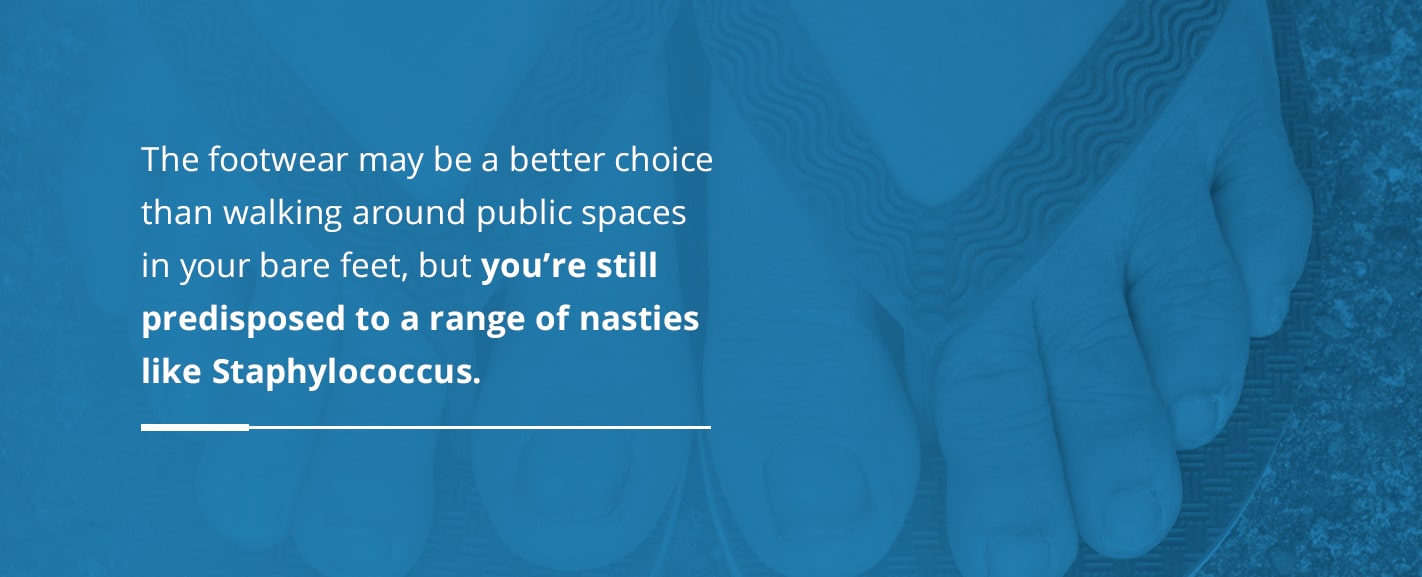
While flip-flops offer some level of protection at the pool or on the beach, they still put your feet at risk for bacterial, fungal and viral infections. Yes, the footwear may be a better choice than walking around public spaces in your bare feet, but you’re still predisposed to a range of nasties like Staphylococcus.
Staphylococcus is a type of bacterium that can irritate the skin on your feet. In the most severe cases, the infection can lead to amputation. You can increase your chances of intense symptoms if you walk around with open wounds on your feet — meaning anything from a cut on your toe to cosmetic exfoliation.
The level at which your body reacts to an infection also depends on your current state of health. If you are healthy, your immune system can protect you well. However, you can experience a more severe infection if you’re already sick.
Athlete’s foot is another condition you can get while wearing flip-flops regularly. It’s a contagious infection that you can pick up from showers and other public areas. You also can become exposed to a form of HPV that causes warts.
Form Blisters
If you begin to feel pain on top of your foot after wearing flip-flops, it can mean the straps are rubbing against your skin. If you’re wearing the wrong size shoe thong, it can even go as far as bruising the top of your feet. The thin piece of rubber or fabric strap is the only material holding your foot onto the shoe. It can irritate the skin between your toes as well as on the surface of your foot by causing extreme tenderness and blistering.
If blisters form and pop when you’re not wearing protective shoes, you become vulnerable to bacteria, viruses and fungi. It’s also painful to experience blisters on the top and bottom of your feet.
Increase the Risk of Injuries
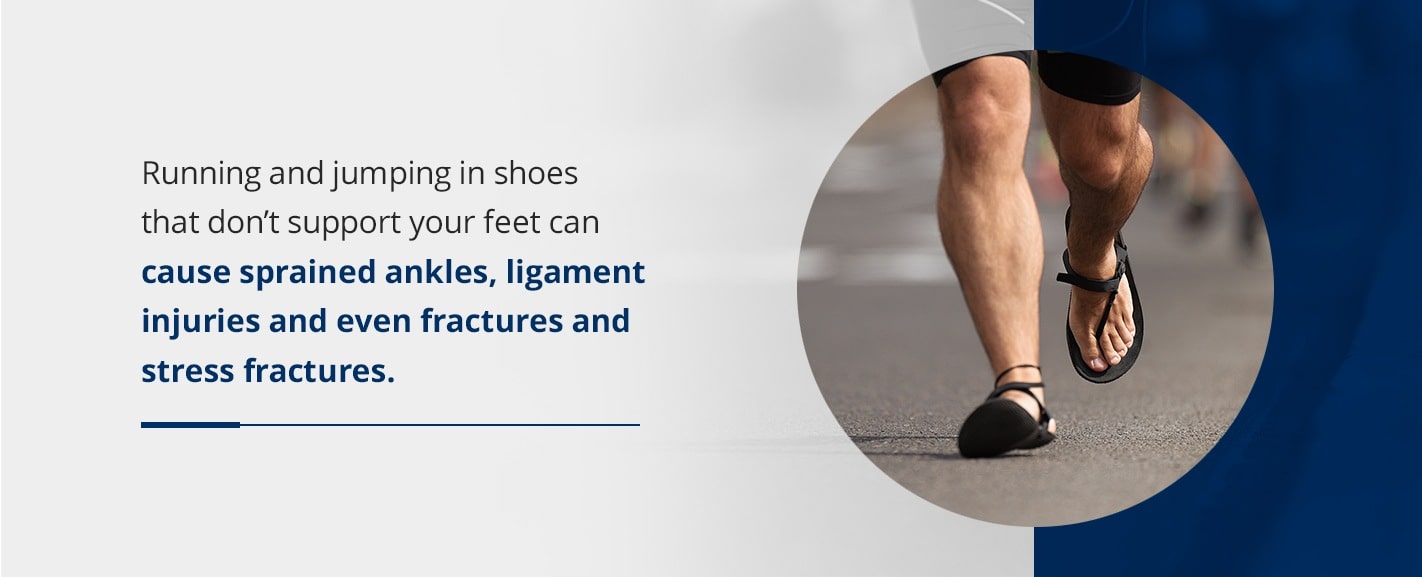
Running and jumping in shoes that don’t support your feet can cause sprained ankles, ligament injuries and even fractures and stress fractures. Never run, hike or play sports in flip-flops to avoid severe injuries. In some cases, you may require surgery from a torn ligament or other mishaps. Flip-flops are only for wear on flat surfaces.
You also shouldn’t wear shoe thongs when performing yard work. You’ll increase the chances of tripping over something, and you don’t want to put yourself at risk when working with tools and heavy machinery. Think about the damages a lawnmower, weed whacker or shovel can do to your feet and toes.
Wearing open-toed shoes also makes you more prone to snake and insect bites. Animals can do some significant damage when you’re wearing open shoes and when you’re least expecting it. Select closed-toed sneakers or boots, as well as long pants, for the best protection when walking in your backyard, woods or open fields.
Ruin Your Heels
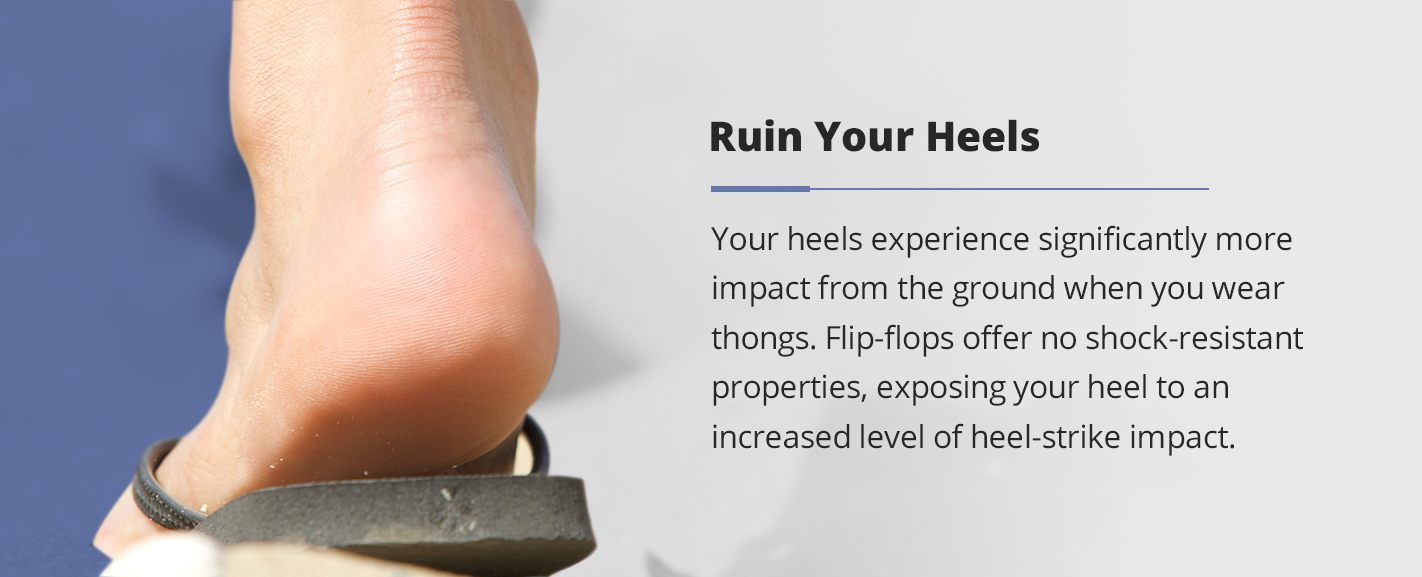
Imagine walking or running in a supportive pair of sneakers — you have protection for your feet, they aren’t sore and you can feel plenty of traction. Now imagine taking all that protection away, leaving yourself with a slim piece of rubber.
Your heels experience significantly more impact from the ground when you wear thongs. Flip-flops offer no shock-resistant properties, exposing your heel to an increased level of heel-strike impact.
Your foot hits the concrete with more force compared to what you feel with the support of a sneaker. Your heels and the balls of your feet may sense pain when walking or standing in open footwear for extended periods.
Slow You Down
It may not come as a surprise, but flip-flops slow you down and make you clumsy. They cause you to take smaller steps compared to when you wear athletic shoes. Shoe thongs also make you take awkward steps as you try to keep the piece of rubber on your feet.
Flip-flops are trickier to walk in, meaning you have to be more cautious. They increase the risk of tripping and even the chances of falling.
Worsen Your Bunions
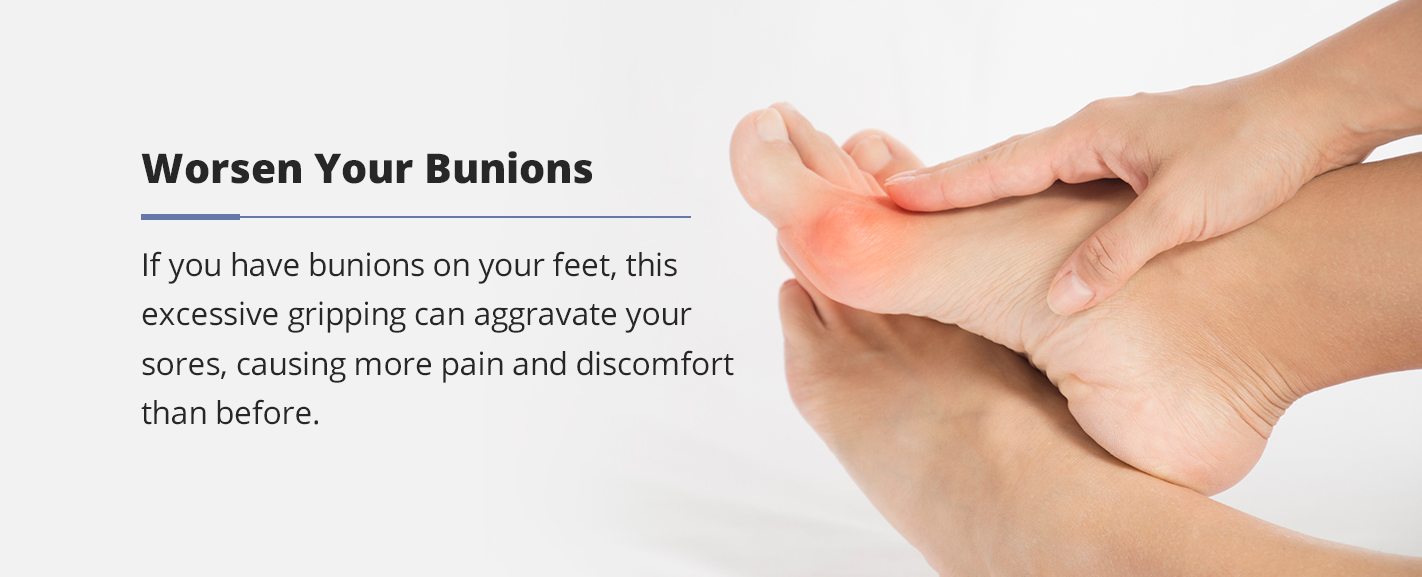
If you want to keep any form of flat shoes on your feet, your toes have to over-grip. If you have bunions on your feet, this excessive gripping can aggravate your sores, causing more pain and discomfort than before.
Slipping on a pair of flops may have you hooked on the convenience factor, but don’t let that fool you for too long. They come with a significant range of symptoms that affect your feet and body, as well as problems that affect other areas of your life.
Flip-Flop Injury Statistics
While the U.S. has very few statistics related to flip-flip footwear, the Journal of the American Podiatric Medical Association found that footwear affects your stride length. Wearing flip-flops causes you to take shorter strides compared to sneakers. They also found that flip-flops increase peak plantar pressures, putting your feet at risk for plantar fasciitis and other abnormalities.
Best Alternatives to Flip-Flops
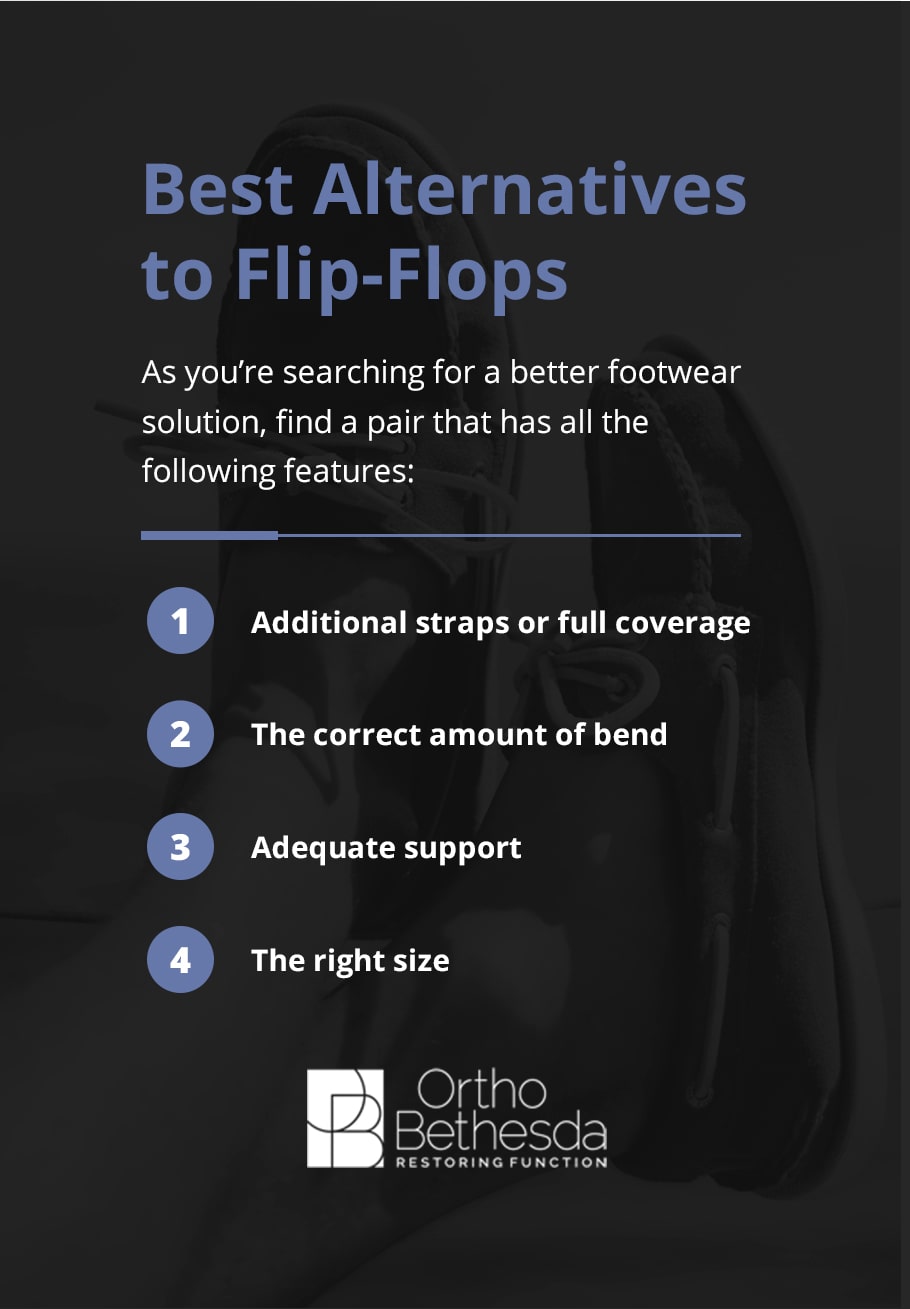
The best alternative to wearing flip-flops is a sneaker that gives you all the support and comfort, whether you’re walking or running. But we understand full-coverage shoes and socks aren’t always ideal in the summer.
If you’re going to wear flip-flops on appropriate occasions, choose a set made of fabric or leather. Natural materials are often safer for your skin and cause less discomfort. The thicker material also gives you a slight boost in support.
If you like the open feeling of a flip-flop but demand more provisions, your best bet is to opt for a pair of sandals. They give you more support than their slimmer counterpart because they usually feature accessories like ankle and surface straps.
Orthotic sandals are also an option if you want the light and airy feel of flip-flops, but with the best possible support and a moldable footbed.
Other flip-flop alternatives include:
- Boat shoes
- Espadrilles
- Woven slip-ons
As you’re searching for a better footwear solution, find a pair that has all the following features:
- Additional straps or full coverage
- The correct amount of bend
- Adequate support
- The right size
Your alternative footwear should have better arch, heel and ankle support, along with stiff soles and some level of traction. You don’t want the soles of the better footwear option to bend in half. You also shouldn’t wear shoes with deteriorating soles.
Choose the right size sandal or shoe, so your feet don’t hang over the edge. You also don’t want your footwear to be too large because it can further your chances of tripping.
Treatment
If you’re someone who wears flip-flops more often than most, you may feel an occasional sense of pain or discomfort. Often, you can subdue any short-term irritations through self-care. The first step is to start wearing more supportive and protective footwear.
You can also place ice on different areas of your feet or body that feel sore, especially after walking a full day in flip-flops. If needed, you can take anti-inflammatory medications to reduce swelling and soreness. If your pain is more localized in your foot region, you can concentrate on foot and heel stretching exercises.
For example, roll the bottom of your foot on a tennis ball to massage and stretch your tissues and ligaments. Even filling a water bottle with water and freezing it can help ease the discomfort. Moving your foot over a cold surface will help with swelling, while also stretching your muscles. People with plantar fasciitis most often use this technique, but it can support you in various ways.
If you’re experiencing lingering and persistent pain in your feet, toes, arch or heels, you will want to seek advice from the experts. A medical specialist will examine your symptoms and often prescribe a change in your daily activity and footwear. They will also suggest physical therapy as an initial step or prescribe wearing a splint at night if necessary. If the symptoms persist or worsen, a specialist may recommend surgery.
We Are Here When You Need Us the Most
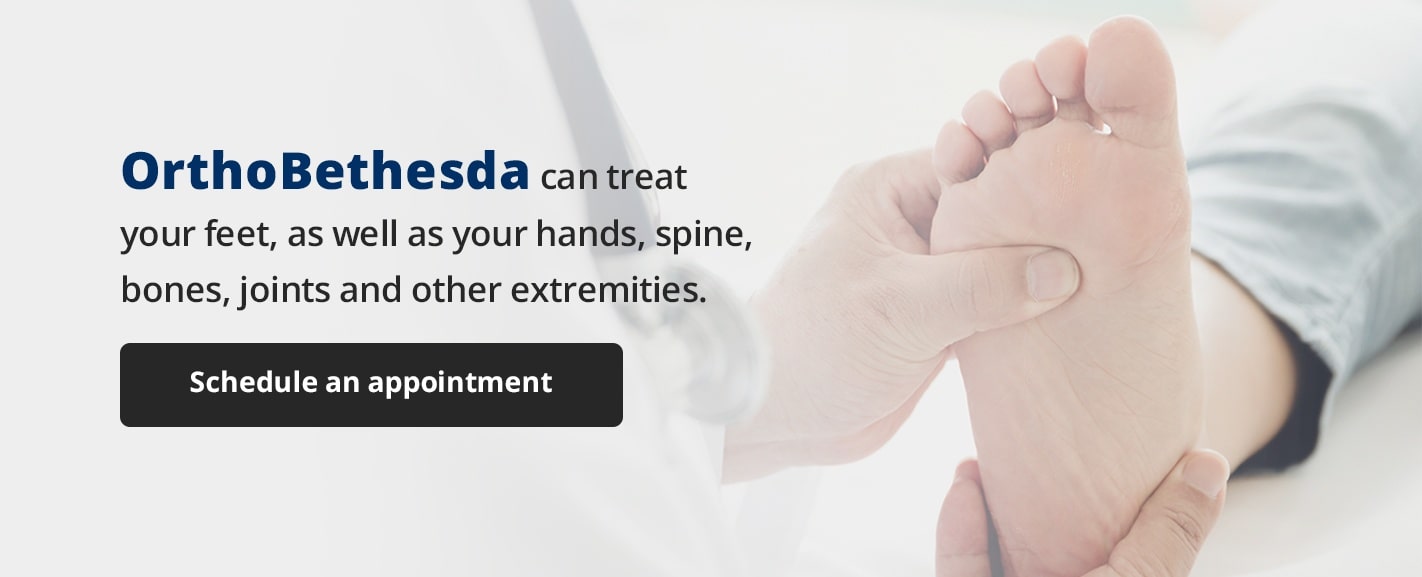
When you’re feeling ongoing pain, OrthoBethesda can treat your feet, as well as your hands, spine, bones, joints and other extremities. We know flip-flops may be your go-to during the summer, but there are other alternatives to keep your feet feeling supported and comfortable. If you’re experiencing arthritis, a tendon or ligament injury, a fracture or other symptoms, our orthopedic care specialists are here to help.
Contact us online to set up an appointment or call us at (301) 530-1010 to speak with one of our assistants. Our physicians have access to modern technology, helping them diagnose your problem and prescribe the best solution.
